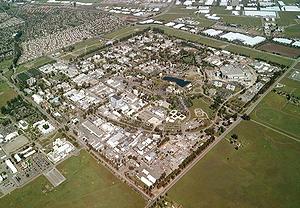Cleanup Resumes at California Nuclear Weapons Research Lab
SAN FRANCISCO, California, April 13, 2009 (ENS)
The U.S. Department of Energy has agreed to cleanup of toxic waste at its Lawrence Livermore National Laboratory in Livermore, California, 40 miles east of San Francisco. The agreement was reached after the U.S. Environmental Protection Agency notified the department in early January that it must immediately restart the shuttered treatment facilities or face escalating fines.
The Energy Department will pay a $165,000 fine for shutting down the cleanup systems and failing to restart them as requested by the EPA. Recent sampling showed that the closure of a large treatment unit on the perimeter of the site resulted in a loss of control of the contaminated groundwater plume offsite.
Groundwater and soil have been contaminated with tritium, uranium-238, the high explosive compounds HMX and RDX, nitrate, perchlorate, solvents and other volatile organic compounds. The primary health threat is drinking contaminated groundwater.
"We're pleased to have reached an agreement with DOE to resume cleanup," said Michael Montgomery, Superfund's assistant director for the EPA's Pacific Southwest region. "The taxpayer's investment in building these cleanup facilities will once again be working to protect the environment."
 |
Lawrence Livermore National Laboratory (Photo courtesy LLNL) |
The 10.5 square-mile Lawrence Livermore National Laboratory Site 300 is a Superfund site, listed on the National Priorities List as one of the most contaminated sites in the country.
The national laboratory is an active multi-program research lab that is the site of the world's largest laser, the National Ignition Facility, completed on March 31.
The National Ignition Facility is expected to allow scientists to achieve fusion ignition in the laboratory, deliver large amounts of energy with extreme precision in billionths of a second, and help ensure the reliability of the U.S. nuclear stockpile without underground nuclear testing.
Research operations at Lawrence Livermore handle, generate, or manage hazardous materials that include radioactive wastes. Hazardous waste treatment activities are carried out on site.
The EPA and the Department of Energy first signed an agreement to clean up Lawrence Livermore in 1988. Groundwater and soil under the site and in neighboring areas are contaminated with volatile organic compounds and other hazardous chemicals.
Some of the systems at the site have already been restarted and DOE is regaining control of contaminated groundwater. The remaining facilities that need to be restarted are subject to an agreed upon schedule that is enforceable by the EPA under a Federal Facility Agreement.
The two federal agencies have also agreed to re-evaluate the cleanup in areas where it is no longer effective, and will involve state regulatory agencies and community stakeholders in the decision-making.
In 2007, the EPA certified that the Energy Department had built the necessary groundwater and soil vapor treatment systems needed to clean up the site. The intention was for the Energy Department to operate the systems until the cleanup standards selected by both federal agencies were met, a process that is expected to take several decades.
In early 2008, the Energy Department informed the EPA that Congress had reduced funding for the cleanup and that as a result the treatment systems would be shut down.
The EPA advised the Energy Department to seek reprogramming of funds from Congress. By the time this was accomplished, 28 treatment systems had been shut down and 60 percent of the technical support staff had been laid off.
Despite receiving full funding in July 2008, the Energy Department had still not restored operation of most of the systems as of January 2009.
The site first was used as a Naval Air Station in the 1940s. In 1951, it was transferred to the U.S. Atomic Energy Commission and was established as a nuclear weapons and magnetic fusion energy research facility.
As far back as 1984, the California Department of Health Services issued an order for compliance to Lawrence Livermore to provide alternative water supplies to residents west of the facility, whose wells had been contaminated by hazardous substances from the lab.
In the spring of 1991, the Department of Energy, DOE, installed a groundwater extraction and treatment system to curtail the migration of a plume of volatile organic compounds, VOCs, near the southern boundary of the site. In the fall of 1992, another plume of VOC-contaminated groundwater was discovered. A second extraction and treatment system was installed to control this plume. DOE also began capping two landfills to prevent rainwater runoff from causing contaminant migration.
In 1995, DOE signed an interim groundwater Record of Decision for the Building 834 operable unit. In November 1995, DOE/LLNL and the regulatory agencies agreed to streamline the cleanup process by implementing removal actions where appropriate. In 1997, DOE signed a final Record of Decision for the General Services Area.
In 1998, groundwater pumping at the site boundary of the High Explosives Process Area operable unit was decided on in an Action Memorandum. In 2001, an Interim Record of Decision was signed for most of the remaining contaminated areas. In 2008, a Final Record of Decision was signed for groundwater in all remaining operable units.
Copyright Environment News Service (ENS) 2009. All rights reserved.
To subscribe or visit go to: http://www.ens-newswire.com